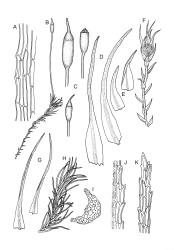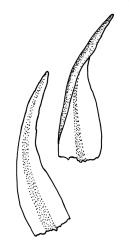- ≡ Anisothecium gracillimum Beckett, Trans. & Proc. New Zealand Inst. 26: 287 (1894)
Plants small, yellow-green. Stems 3–7 mm, in cross-section with a central strand and 2–3 layers of firm-walled cortical cells. Leaves secund, not sheathing, more erect and ± contorted when dry, ovate-lanceolate, lacking distinct shoulders, acute, on lower stems mostly 0.5–0.8 × c. 0.25 mm, ± concave, sinuate and plane at margins; leaves on fertile stems becoming larger (to c. 1.0 mm immediately below perichaetium); upper to mid laminal cells oblong-rectangular, (45–)54–75 × 6–9 µm and 5–7:1, firm-walled, unistratose, smooth, somewhat wider (to c. 15 µm) but otherwise little differentiated near insertion. Costa occupying c. ⅕ the width of the leaf base, well-defined, percurrent, mostly not filling the subula, in cross-section lacking guide cells and with stereids poorly developed or absent; the cells on the adaxial surface scarcely more elongate than adjacent laminal cells. Tubers not seen.
Dioicous. Perichaetia one per stem, not overtopped by innovation; with perichaetial leaves non-sheathing, c. 1.3–1.5 mm, rather abruptly narrowed (but not shouldered) to subula, with costae nearly filling the subulae and often appearing excurrent. Setae 4–8 mm, flexuose, dextrorse, pale brown; capsules erect, symmetric, short-cylindric, smooth and narrowed below the mouth when dry, (0.4–)0.5–0.8(–1.0) mm, not strumose; mouth transverse; exothecial cells ± oblong, not in distinct columns, firm-walled (transverse walls not notably thinner-walled); stomata absent; annulus apparently absent; operculum rostrate, c. 0.6 mm. Peristome teeth inserted c. 50 µm below the capsule mouth, c. 300–325 × 45 µm (including basal fused portion), connate at base for c. 60–90 µm, divided c. ½ to base into two uneven forks, the outer surface of the lower tooth bearing rather coarse trabeculae traversing the full width of the tooth, the inner surface with a zig-zag line that divides the tooth vertically into asymmetric segments, the entire tooth in surface view appearing vertically papillose-striolate below. Calyptra as per genus. Spores 12–15 µm, brown, often persisting as tetrads in deoperculate capsules.
In N.Z. confusion is most likely with D. schreberiana. In addition to differences in capsule symmetry, leaf set and stature, spore dimensions, the longer laminal cells, lack of distinct ranks of exothecial cells, and the direction of the seta twisting serve to differentiate D. gracillima. The transverse trabeculae on the outer surface of the peristome teeth appear to be coarser and more prominent in D. gracillima than in any other N.Z. species of Dicranella.
NI: S Auckland (Waiotapu, Ātiamuri, Murupara), Wellington (Ōhakune); SI: Nelson (Graham Valley, Kawatiri), Canterbury (Kowai Bush), Otago (Berwick, Swampy Summit, Fraser’s Gully, Waihola, Pine Hill, Wānaka). Collections from Marlborough (Waimā River and Maude I.) in WELT have not been verified, but are plausible given the known distribution.
Apparently endemic.
Occurring on clay, silt, or occasionally sand at the margins of streams or drainage ditches, usually shaded. The highest elevation recorded on the North I. is c. 600 m at Ōhakune. On the South I. ranging in elevation from near sea level (Berwick) to c. 700 m (Swampy Summit). Philonotis tenuis and Fissidens asplenioides are commonly associated species.
The small stature, secund leaves, and erect capsules distinguish this species. Neither the vegetative nor the perichaetial leaves are sheathing, and the leaves on the lower portions of fruiting stems are decidedly reduced. The peristome teeth are connate at their base and bear prominent transverse trabeculae on their outer surface. The elongate mid laminal cells and the complete or near absence of costal stereids corroborate identifications in difficult collections. Sterile material of this species cannot be named with confidence.
The transverse trabeculae on the outer surface of the peristome teeth appear to be coarser and more prominent (well seen in K.W. Allison 3634 from Berwick State Forest, Otago L.D., CHR 532245) in D. gracillima than in any other N.Z. species of Dicranella.
Dicranella gracillima is allied to D. rufescens of the northern hemisphere and monographic study may eventually show them to be conspecific. However, the name D. gracillima is retained here since the capsules here are more variable in size and generally somewhat larger than in D. rufescens.
Beckett’s (1894) protologue cites the Kowai Bush material and W. Bell collection from Pine Hill, Otago L.D. as syntypes. Beckett’s original drawings, from which the plate in the protologue is derived, are in his herbarium and clearly marked as representations of the Kowai Bush syntype, which was therefore designated as the lectotype by Fife (2019a).










